翻译技巧3_增译法
翻译—增译法
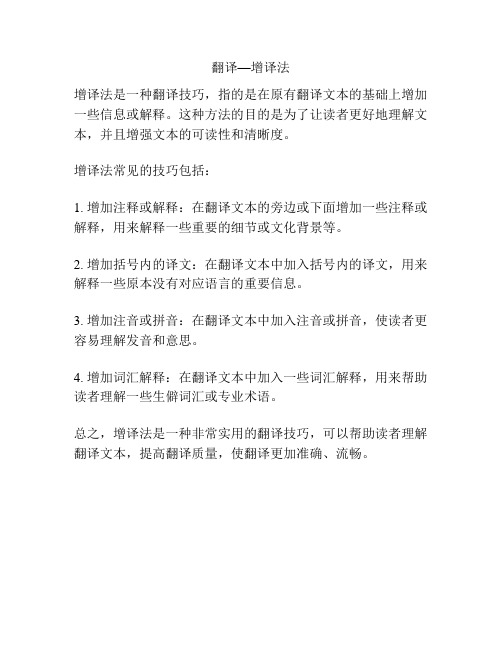
翻译—增译法
增译法是一种翻译技巧,指的是在原有翻译文本的基础上增加一些信息或解释。
这种方法的目的是为了让读者更好地理解文本,并且增强文本的可读性和清晰度。
增译法常见的技巧包括:
1. 增加注释或解释:在翻译文本的旁边或下面增加一些注释或解释,用来解释一些重要的细节或文化背景等。
2. 增加括号内的译文:在翻译文本中加入括号内的译文,用来解释一些原本没有对应语言的重要信息。
3. 增加注音或拼音:在翻译文本中加入注音或拼音,使读者更容易理解发音和意思。
4. 增加词汇解释:在翻译文本中加入一些词汇解释,用来帮助读者理解一些生僻词汇或专业术语。
总之,增译法是一种非常实用的翻译技巧,可以帮助读者理解翻译文本,提高翻译质量,使翻译更加准确、流畅。
翻译常用的八种技巧
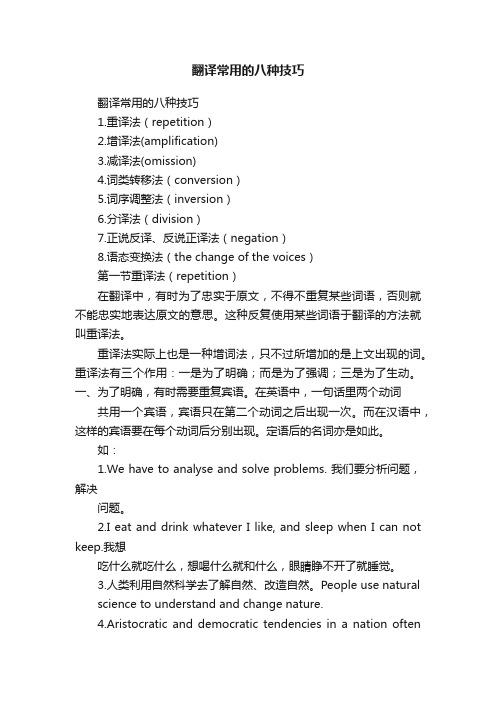
翻译常用的八种技巧翻译常用的八种技巧1.重译法(repetition)2.增译法(amplification)3.减译法(omission)4.词类转移法(conversion)5.词序调整法(inversion)6.分译法(division)7.正说反译、反说正译法(negation)8.语态变换法(the change of the voices)第一节重译法(repetition)在翻译中,有时为了忠实于原文,不得不重复某些词语,否则就不能忠实地表达原文的意思。
这种反复使用某些词语于翻译的方法就叫重译法。
重译法实际上也是一种增词法,只不过所增加的是上文出现的词。
重译法有三个作用:一是为了明确;而是为了强调;三是为了生动。
一、为了明确,有时需要重复宾语。
在英语中,一句话里两个动词共用一个宾语,宾语只在第二个动词之后出现一次。
而在汉语中,这样的宾语要在每个动词后分别出现。
定语后的名词亦是如此。
如:1.We have to analyse and solve problems. 我们要分析问题,解决问题。
2.I eat and drink whatever I like, and sleep when I can not keep.我想吃什么就吃什么,想喝什么就和什么,眼睛睁不开了就睡觉。
3.人类利用自然科学去了解自然、改造自然。
People use naturalscience to understand and change nature.4.Aristocratic and democratic tendencies in a nation oftenshowthemselves in its speech.民族的贵族倾向和民族倾向常在其言语中表现出来。
5.我们来修改安全规则和卫生规则吧。
Let’s revise our safety andsanitary regulations.二、英语常用省略,但为了明确,也为了强调某些内容,在汉语中常常要将省去的部分重译出来。
翻译方法之增译法、减译法、重复法

翻译方法之增译法、减译法、重复法•英汉两种语言,由于表达方式不尽相同,翻译时既可能要将词义进行转换,有可能要在词量上加以增减。
•有的时候,为了明确、强调或生动,也需要将一些关键性的词加以重复。
•什么叫增译法?我们可以这样确定它的定义:为了使译文忠实地表达原文的意思与风格,并使译文合乎表达习惯,必须按意义上(修辞上)和句法上增加一些词语,这就叫做增译法。
•一、根据意义(修辞)上的需要•二、根据句法上的需要一、根据意义(修辞)上的需要•(一)增加动词•(二)增加形容词•(三)增加副词•(四)增加名词•(五)增加表示名词复数的词•(六)增加表达时态的词•(七)增加语气助词•(八)增加量词•(九)增加根据上下文需要及反映背景情况的词•(十)增加概括词•(十一)增加承上启下的词(一)增加动词•根据意义的需要,可以在名词前后增加动词。
•如:In the evening, after the banquets, the concerts and the table tennis exhibitions, he would work on ……Practice•They talked for almost eight hours, through dinner and well into the night. •My work, my family, my friends were more than enough to fill my time.(二)增加形容词•With what enthusiasm the Chinese people are building socialism!中国人民正在以多么高涨的热情建设社会主义啊!•O, Tom Canty, born in rags and dirt and misery, what sight is this! (Mark Twain) 出生在破烂、肮脏和苦难中,现在这番景象却是多么煊赫啊!Practice•With the meeting to begin in hours, I hadn’t have time to worry about such trifles.我没有闲功夫为这些琐事操心。
英语 常用十大翻译技巧
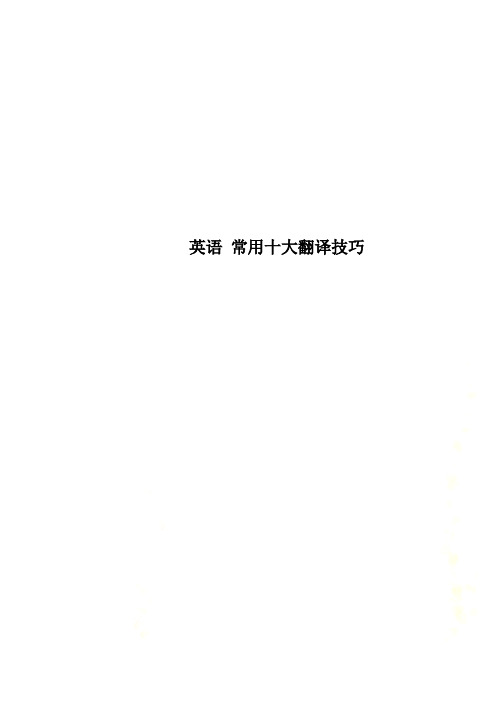
英语常用十大翻译技巧常用十大翻译技巧之一:增译法增译法:指根据英汉两种语言不同的思维方式、语言习惯和表达方式,在翻译时增添一些词、短句或句子,以便更准确地表达出原文所包含的意义。
这种方式多半用在汉译英里。
汉语无主句较多,而英语句子一般都要有主语,所以在翻译汉语无主句的时候,除了少数可用英语无主句、被动语态或"There be…"结构来翻译以外,一般都要根据语境补出主语,使句子完整。
英汉两种语言在名词、代词、连词、介词和冠词的使用方法上也存在很大差别。
英语中代词使用频率较高,凡说到人的器官和归某人所有的或与某人有关的事物时,必须在前面加上物主代词。
因此,在汉译英时需要增补物主代词,而在英译汉时又需要根据情况适当地删减。
英语词与词、词组与词组以及句子与句子的逻辑关系一般用连词来表示,而汉语则往往通过上下文和语序来表示这种关系。
因此,在汉译英时常常需要增补连词。
英语句子离不开介词和冠词。
另外,在汉译英时还要注意增补一些原文中暗含而没有明言的词语和一些概括性、注释性的词语,以确保译文意思的完整。
总之,通过增译,一是保证译文语法结构的完整,二是保证译文意思的明确。
如:(1)What about calling him right away?马上给他打个电话,你觉得如何?(增译主语和谓语)(2)If only I could see the realization of the four modernizations.要是我能看到四个现代化实现该有多好啊!(增译主句)(3)Indeed, the reverse is true.实际情况恰好相反。
(增译名词)(4)就是法西斯国家本国的人民也被剥夺了人权。
Even the people in the fascist countries were stripped of their human rights.(增译物主代词)(5)只许州官放火,不许百姓点灯。
翻译之增译法
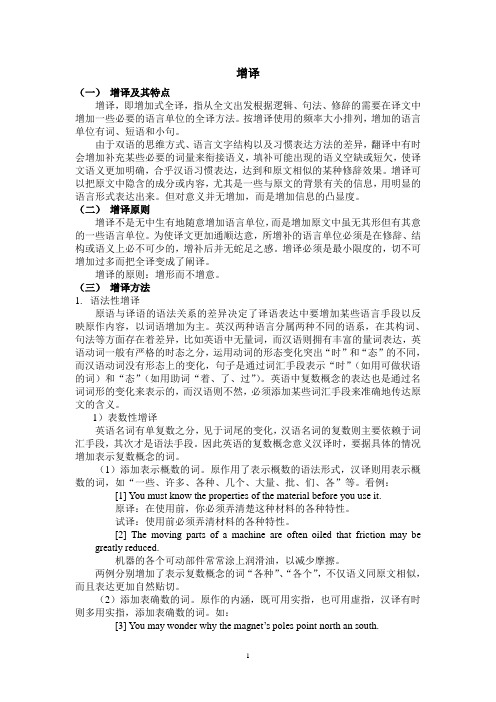
增译(一)增译及其特点增译,即增加式全译,指从全文出发根据逻辑、句法、修辞的需要在译文中增加一些必要的语言单位的全译方法。
按增译使用的频率大小排列,增加的语言单位有词、短语和小句。
由于双语的思维方式、语言文字结构以及习惯表达方法的差异,翻译中有时会增加补充某些必要的词量来衔接语义,填补可能出现的语义空缺或短欠,使译文语义更加明确,合乎汉语习惯表达,达到和原文相似的某种修辞效果。
增译可以把原文中隐含的成分或内容,尤其是一些与原文的背景有关的信息,用明显的语言形式表达出来。
但对意义并无增加,而是增加信息的凸显度。
(二)增译原则增译不是无中生有地随意增加语言单位,而是增加原文中虽无其形但有其意的一些语言单位。
为使译文更加通顺达意,所增补的语言单位必须是在修辞、结构或语义上必不可少的,增补后并无蛇足之感。
增译必须是最小限度的,切不可增加过多而把全译变成了阐译。
增译的原则:增形而不增意。
(三)增译方法1.语法性增译原语与译语的语法关系的差异决定了译语表达中要增加某些语言手段以反映原作内容,以词语增加为主。
英汉两种语言分属两种不同的语系,在其构词、句法等方面存在着差异,比如英语中无量词,而汉语则拥有丰富的量词表达,英语动词一般有严格的时态之分,运用动词的形态变化突出“时”和“态”的不同,而汉语动词没有形态上的变化,句子是通过词汇手段表示“时”(如用可做状语的词)和“态”(如用助词“着、了、过”)。
英语中复数概念的表达也是通过名词词形的变化来表示的,而汉语则不然,必须添加某些词汇手段来准确地传达原文的含义。
1)表数性增译英语名词有单复数之分,见于词尾的变化,汉语名词的复数则主要依赖于词汇手段,其次才是语法手段。
因此英语的复数概念意义汉译时,要据具体的情况增加表示复数概念的词。
(1)添加表示概数的词。
原作用了表示概数的语法形式,汉译则用表示概数的词,如“一些、许多、各种、几个、大量、批、们、各”等。
看例:[1] You must know the properties of the material before you use it.原译:在使用前,你必须弄清楚这种材料的各种特性。
英语翻译十大技巧

英汉两种语言在句法、词汇、修辞等方面均存在着很大的差异,因此在进行英汉互译时必然会遇到很多困难,需要有一定的翻译技巧作指导。
常用的翻译技巧有增译法、省译法、转换法、拆句法、合并法、正译法、反译法、倒置法、包孕法、插入法、重组法和综合法等。
这些技巧不但可以运用于笔译之中,也可以运用于口译过程中,而且应该用得更加熟练,因为口译工作的特点决定了译员没有更多的时间进行思考。
翻译一、增译法指根据英汉两种语言不同的思维方式、语言习惯和表达方式,在翻译时增添一些词、短句或句子,以便更准确地表达出原文所包含的意义。
这种方式多半用在汉译英里。
汉语无主句较多,而英语句子一般都要有主语,所以在翻译汉语无主句的时候,除了少数可用英语无主句、被动语态或“There be…”结构来翻译以外,一般都要根据语境补出主语,使句子完整。
英汉两种语言在名词、代词、连词、介词和冠词的使用方法上也存在很大差别。
英语中代词使用频率较高,凡说到人的器官和归某人所有的或与某人有关的事物时,必须在前面加上物主代词。
因此,在汉译英时需要增补物主代词,而在英译汉时又需要根据情况适当地删减。
英语词与词、词组与词组以及句子与句子的逻辑关系一般用连词来表示,而汉语则往往通过上下文和语序来表示这种关系。
因此,在汉译英时常常需要增补连词。
英语句子离不开介词和冠词。
另外,在汉译英时还要注意增补一些原文中暗含而没有明言的词语和一些概括性、注释性的词语,以确保译文意思的完整。
总之,通过增译,一是保证译文语法结构的完整,二是保证译文意思的明确。
如:①、What about calling him right away?马上给他打个电话,你觉得如何?(增译主语和谓语)②、If only I could see the realization of the four modernizations.要是我能看到四个现代化实现该有多好啊!(增译主句)③、Indeed, the reverse is true.实际情况恰好相反。
翻译的八大常用技巧

作用与意义1. 重译法:为了明确、为了强调、为了生动2. 增译法:为了更忠实于原文的意思,而又更合乎译文的表达习惯3. 减译法:源语言与目标语言互换的时候增译法就成了减译法4. 词类转移法:语言之间表达习惯的差异迫使译文中词类发生改变,词序有时也随之变化5. 词序调整法:语言之间构成形式并非完全相同,做必不可少的词序改变6. 分译法:主要用于长句的翻译,有时存在于词语语义的分译7. 正反翻译法:由于语言的习惯差异---正话反说,反话正说8. 语态变换法:主要指英汉两种语言间的主动与被动语态的转换In the event of one of the contracting parties being attacked by Japan or any other state allied with it and thus being involved in a state of war, the other contracting party will immediate render military and other assistance with all means at its disposal.一旦缔约国的一方受到日本或者与日本同盟的任何国家之侵袭,因而处于战争状态时,缔约国的另一方即尽全力给与军事及其他援助。
We have to analyze and solve problems.我们要分析问题,解决问题。
A large family has its difficulties.大(家庭)有大(家庭)的难处。
Our old clothes and few sticks of furniture have been pawned or sold.这几件旧衣服和这些旧家具,当的当了,卖的卖了。
Lightly floats and drifts the boat, and gently flows and flaps my gown.舟遥遥以轻扬,风飘飘而吹衣。
汉译英增译法
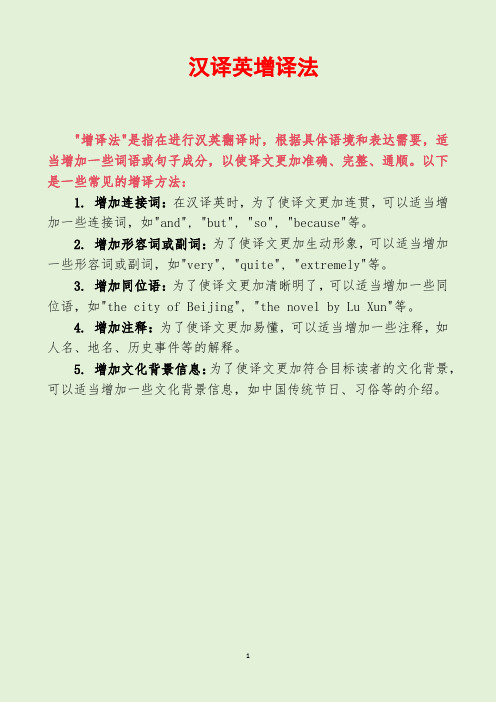
汉译英增译法
"增译法"是指在进行汉英翻译时,根据具体语境和表达需要,适当增加一些词语或句子成分,以使译文更加准确、完整、通顺。
以下是一些常见的增译方法:
1. 增加连接词:在汉译英时,为了使译文更加连贯,可以适当增加一些连接词,如"and", "but", "so", "because"等。
2. 增加形容词或副词:为了使译文更加生动形象,可以适当增加一些形容词或副词,如"very", "quite", "extremely"等。
3. 增加同位语:为了使译文更加清晰明了,可以适当增加一些同位语,如"the city of Beijing", "the novel by Lu Xun"等。
4. 增加注释:为了使译文更加易懂,可以适当增加一些注释,如人名、地名、历史事件等的解释。
5. 增加文化背景信息:为了使译文更加符合目标读者的文化背景,可以适当增加一些文化背景信息,如中国传统节日、习俗等的介绍。
1。
英语翻译中常用的十种技巧大盘点

英语翻译中常用的十种技巧大盘点英汉两种语言在句法、词汇、修辞等方面均存在着很大的差异,因此在进行英汉互译时必然会遇到很多困难,需要有一定的翻译技巧作指导。
下面,小编就为大家介绍一下英语翻译中常用的十大技巧,以供大家参考学习。
一、增译法指根据英汉两种语言不同的思维方式、语言习惯和表达方式,在翻译时增添一些词、短句或句子,以便更准确地表达出原文所包含的意义。
这种方式多半用在汉译英里。
汉语无主句较多,而英语句子一般都要有主语,所以在翻译汉语无主句的时候,除了少数可用英语无主句、被动语态或“There be…”结构来翻译以外,一般都要根据语境补出主语,使句子完整。
英汉两种语言在名词、代词、连词、介词和冠词的使用方法上也存在很大差别。
英语中代词使用频率较高,凡说到人的器官和归某人所有的或与某人有关的事物时,必须在前面加上物主代词。
因此,在汉译英时需要增补物主代词,而在英译汉时又需要根据情况适当地删减。
英语词与词、词组与词组以及句子与句子的逻辑关系一般用连词来表示,而汉语则往往通过上下文和语序来表示这种关系。
因此,在汉译英时常常需要增补连词。
英语句子离不开介词和冠词。
另外,在汉译英时还要注意增补一些原文中暗含而没有明言的词语和一些概括性、注释性的词语,以确保译文意思的完整。
总之,通过增译,一是保证译文语法结构的完整,二是保证译文意思的明确。
如:①、What about calling him right away?马上给他打个电话,你觉得如何? (增译主语和谓语)②、If only I could see the realization of the four modernizations.要是我能看到四个现代化实现该有多好啊!(增译主句)③、Indeed, the reverse is true.实际情况恰好相反。
(增译名词)④、就是法西斯国家本国的人民也被剥夺了人权。
Even the people in the fascist countries were stripped of their human rights.(增译物主代词)⑤、只许州官放火,不许百姓点灯。
英汉互译八种技巧
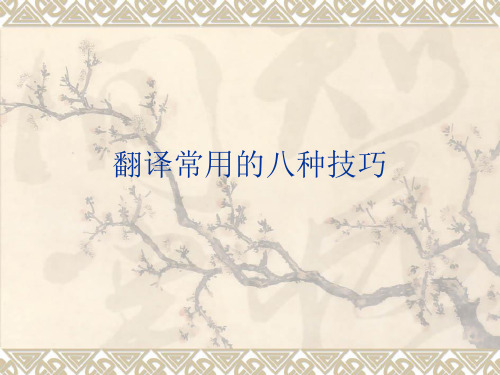
❖ 6.重复副词 ❖ Nels had it all written out neatly. ❖ 纳尔斯把它写得清清楚楚。 ❖ By and by the building rose up. ❖ 楼房一点一点地升起来了。 7,使用四字词组 Come over and have a rest. 过来休息休息。
❖ 先生们尽管可以高呼和平,和平!但是依然没有和 平。
❖ We must enrich our cultural and material lives.
我们必须丰富我们的精神生活和物质生活。 (宾语前有多个定语时,要重复这个做宾语 的名词)
2)重复做表语的名词
This is a victorious conference that shows our unity.
8. 留得青山在, 不怕没柴烧。 So long as green hills remain, there will never be a shortage of firewood.
3. 减译法
❖ 增译法的反面
❖ 减译法是指原文中有些词在译文中不译出来, 因为译文中虽无其词而已有其意,或者在译文 中是不言而喻的;
❖ I am looking forward to the holidays. ❖ 我们等待假日的到来。
❖ Much of our morality is customary. ❖ 我们大部分的道德观念都有习惯性。
❖ Reading makes a full man; conference a ready man; and writing an exact man.
1. 重复法
1. 汉语重复,英译时也重复;
翻译方法之增译法、减译法、重复法

翻译方法之增译法、减译法、重复法•英汉两种语言,由于表达方式不尽相同,翻译时既可能要将词义进行转换,有可能要在词量上加以增减。
•有的时候,为了明确、强调或生动,也需要将一些关键性的词加以重复。
•什么叫增译法?我们可以这样确定它的定义:为了使译文忠实地表达原文的意思与风格,并使译文合乎表达习惯,必须按意义上(修辞上)和句法上增加一些词语,这就叫做增译法。
•一、根据意义(修辞)上的需要•二、根据句法上的需要一、根据意义(修辞)上的需要•(一)增加动词•(二)增加形容词•(三)增加副词•(四)增加名词•(五)增加表示名词复数的词•(六)增加表达时态的词•(七)增加语气助词•(八)增加量词•(九)增加根据上下文需要及反映背景情况的词•(十)增加概括词•(十一)增加承上启下的词(一)增加动词•根据意义的需要,可以在名词前后增加动词。
•如:In the evening, after the banquets, the concerts and the table tennis exhibitions, he would work on ……Practice•They talked for almost eight hours, through dinner and well into the night. •My work, my family, my friends were more than enough to fill my time.(二)增加形容词•With what enthusiasm the Chinese people are building socialism!中国人民正在以多么高涨的热情建设社会主义啊!•O, Tom Canty, born in rags and dirt and misery, what sight is this! (Mark Twain) 出生在破烂、肮脏和苦难中,现在这番景象却是多么煊赫啊!Practice•With the meeting to begin in hours, I hadn’t have time to worry about such trifles.我没有闲功夫为这些琐事操心。
本地化翻译技巧之增译和省译

本地化翻译技巧之增译和省译英语和汉语的语言习惯差异很大,这一方面是文化的差异所致,另一方面也是语言各自的特征。
译员要做到本地化的翻译就必须吃透两种语言间的异同。
今天就给大家列举两种常见的本地化翻译的技巧,并列举一些例子加以说明。
一、增译法:指根据英汉两种语言不同的思维方式、语言习惯和表达方式,在翻译时增添一些词、短句或句子,以便更准确地表达出原文所包含的意义。
这种方式多半用在汉译英里。
1、What about calling him right away?马上给他打个电话,你觉得如何?(增译主语和谓语)2、If only I could see the realization of the four modernizations.要是我能看到四个现代化实现该有多好啊!(增译主句)3、Indeed, the reverse is true实际情况恰好相反。
(增译名词)4、就是法西斯国家本国的人民也被剥夺了人权。
Even the people in the fascist countries were stripped of their human rights.(增译物主代词)5、只许州官放火,不许百姓点灯。
While the magistrates were free to burn down house, the common people were forbidden to light lamps. (增译连词)6、这是我们两国人民的又一个共同点。
This is yet another common point between the people of our two countries.(增译介词)7、在人权领域,中国反对以大欺小、以强凌弱。
In the field of human rights, China opposes the practice of the big oppressing the small and the strong bullying the weak.(增译暗含词语)8、三个臭皮匠,合成一个诸葛亮。
八、翻译技巧(3)增译法和重复法

1
长春工程学院教案用纸
a)(大自然的)恩赐:presents (presents 一般指馈赠的礼物, 而不是 大自然或上帝的恩赐, 应译为 “All people are blessed by nature, rich or poor alike.) b)人, 人们:human beings, men (此处只能用 people,因为从“无论 贫富”我们可以看出作者关心的是人们的社会属性, 而不是他们 区别于动物或植物的自然属性或性别。 ” c) 种植(庄稼和葡萄) :plant crops and grapes (此处的“种植”一词 包括了“种”和“养”两个方面, 所以应该用 “grow”一词。 ) d) 栽(花) :plant flowers (同上) e) 除草:get rid of grass (get rid of grass 的意思是把草全部消灭掉, 根据语境应译为: mow one’s lawn / weed one’s garden) f) 温馨家园: warm houses/residences/family (用 warm houses/residences 只译出了“ (温馨)家园”的概念意义, 因为 house 和 residence 只 指建筑物或地方,没有温馨的感情色彩, 也没有“家园”一词给 人的许多美好的联想。family 则指人际关系, 而不是“家园” 所 , 以“温馨家园”应译为 sweet homes 为好。 原因分析:学生犯这类错误的原因是缺乏语义方面的知识,翻译中往 原因分析 往只注意词的概念意义,忽视了或不了解词的内涵意义、 感情意义和搭配意义,有时概念意义也不十分了解。 2) 词的搭配方面的错误, 例如: 词的搭配方面的错误, a) 一致并深深地依赖着:depend deeply and unanimously/identically (depend 通常可以用 heavily, completely 和 absolutely 等词修饰, 但 不 能 用 deeply , unanimously 和 identically 等 词 修 饰 。 而 unanimously 一词通常只能修饰 agree 或 vote.) b) 种植庄稼和葡萄:raise crops and grapes (raise 只能和表示动物的 名词搭配, 用语植物通常只能用 grow 或 plant。) 3) 词序方面的错误 学生对英汉语词序差异重视不够或没有注意, 实际上英汉词序 有很大差别。 例如: a) poor or rich, whether we are poor or not: 英汉两中语言在词序上有着 很大的差异。汉语的词序比较灵活, 英语的词序比较固定。有时, 汉语的成语有一定的词序, 不可随意颠倒, 如“嫌贫爱富”“杀 、 富济贫”等, 但“贫富”不能说成“富贫” 。而英语中只能说 rich and poor。同样“中老年”只能译成“ old and middle-aged” b) dance and sing 汉语中可以说唱歌跳舞, 但英语只能说 sing and dance 或 singing and dancing。 4) 语篇层次方面的错误 在语篇层次上主要有以下几方面的问题:
第三章翻译的基本技巧之-增译法

第三章翻译的基本技巧增译法(amplification)•The dust, the uproar and the growing darkness threw everything into chaos.•In April, there was the “ping” heard around the world. In July, the ping “ponged”.原译:四月里,全世界听到“乒”的一声;七月里,乒又“乓” 了。
改译:四月里,全世界听到中国“乒”的一声把球打了出去;到了七月,美国“乓”的一声把球打了回来。
•Their host carved, poured, served, cut bread, talked, laughed, proposed health.•原译:他们的主人又切又倒又服务又切面包;又说又笑又祝健康。
改译:热情的主人又是切肉,又是斟酒,又是上菜,又是切面包;说啊,笑啊,敬酒啊,忙个不停。
增译法•当然,增译法并不意味着译者可以随心所欲地添枝加叶,而必须遵守一条基本原则,即增加那些在句法上、语义上或修辞上必不可少的词语,也就是增加原文字面虽未出现但却为其实际内容所包含的词语。
下面分别介绍英汉翻译中运用增译法的两种主要类型。
•Amplification means supplying necessary words in our translation on the basis of accurate comprehension of the original.Outline•根据意义或修辞上的需要•根据句法上的需要Exercises一、根据意义或修辞上的需要1.1 增加动词1.2 增加形容词1.3 增加副词1.4 增加名词1.5 增加表示名词复数的词1.6 增加表达时态的词1.7 增加语气助词1.8 增加量词1.9 增加概括词1.10 增加承上启下的词1.1增加动词•In the evening, after the banquets, the concerts and the table tennis exhibitions, he would work on the drafting of the final communiqué.•晚上在参加宴会、出席音乐会、观看乒乓球表演之后,他还得起草最后公报。
- 1、下载文档前请自行甄别文档内容的完整性,平台不提供额外的编辑、内容补充、找答案等附加服务。
- 2、"仅部分预览"的文档,不可在线预览部分如存在完整性等问题,可反馈申请退款(可完整预览的文档不适用该条件!)。
- 3、如文档侵犯您的权益,请联系客服反馈,我们会尽快为您处理(人工客服工作时间:9:00-18:30)。
1. Like most wildlife,deer reproduce,grow, and store fat in the summer and fall when there is plenty of nutritious food available. 与大多数野生动物一样,鹿在营养丰富、食物 充足的夏秋两季,繁殖、生长储存脂肪。
1. 4 增加副词
有些动词根据原文的上下文可以增加适当的副 词,以确切表示原意。 1)As he sat down and began talking, words poured out. 他一坐下来就讲开了,滔滔不绝地讲个没完。
2)The crowds mmplification
1.1 增加动词 1.2 增加名词 1.3 增加概括词 1.4 增加副词 1.5 增加量词 1.6 增加表达复数的词 1.7 增加表达时态的词
1. 1 增加动词
根据意义上的需要,可在名词前后
增加动词使其意思明确,通顺自然。 例: concert→听音乐会; match→观看比赛; party→参加聚会; speech→发表讲话; funeral→出席葬礼,等等。
1. Lexical Amplification(从词汇上考虑的增 词) 2. Syntactical Amplification (从句法结构上 考虑的增词) 3. Cultural Amplification (从文化上考虑的增 词) 4. Rhetorical Amplification (从修辞上考虑)
② He is a complicated man---moody, mercurial, with a melancholy streak. 他是一个性格复杂的人——喜怒无常,反复 多变,有些忧郁寡欢。
d. 在不及物动词后面增加名词 英语中的某些动词在用作不及物动词的时候,虽 然后面并没有带宾语,但宾语实际上是隐含在动词后 面的。所以在翻译成汉语时,往往要把隐含的宾语翻 译出来。 1)Day after day he came to his work—sweeping, scrubbing, cleaning. 他每天来干活——扫地、擦地板、收拾房间。
Amplification in Translation
增译法
译文不能对原文意思有任何的增加或减少,这 是从事翻译工作必须遵守的一项基本要求。 但是,这并不是说译文在文字上不能有任何增 减。 有时,为了确切、充分地表达原意,或为使译 文生动、通顺,符合汉语的习惯,常常要在译 文里做必要的文字上的增补或省略。
b. 在具体名词后面增加名词 a) 当具体名词表达某种抽象概念时,在译文中也常常 需要根据上下文增加一些适当的名词。 1) He allowed the father to be overruled by the judge,and declared his own son guilty。 他让法官的职责战胜父子的私情,而判决他儿子有罪。
1. 2 增加名词
Adding nouns after abstract nouns在抽象名词 后面增加名词 Adding nouns after concrete nouns 在具体名 词后面增加名词 Adding nouns before adjectives 在形容词前面 增加名词 Adding nouns after intransitive verbs 在不及物 动词后面增加名词
1. He bought her a Benz as a birthday gift.
他给她买了一辆奔驰汽车作为生日
2. We won’t retreat; we never have(…) and
礼物。
我们不会后退,我们从来没有后退
never will(…).
过,将来也决不后退。
3. This laser copier is indeed cheap and fine. 这台激光复印机真是价廉物美。
2. The advantages of the hall are bright, spacious, fashionable and without echo.
这个大厅有四大优点:宽敞、明亮、样式新颖、 没有回声。
3. They talked about wage, price and inflation. 他们谈及工资、物价、通货膨胀等问题。
1)In the evening, after the banquets, the concerts and the table tennis exhibition, he would work on the drafting of the final communique. 晚上在参加宴会、出席音乐会、观看乒乓球表 演之后,他还得起草最后的公报。
2)After the football match, he’s got an important meeting. 在观看足球赛之后,他有一个重要会议要参加。 3)There were no speeches, no foreign diplomats, no “ordinary Chinese” with paper flags and flowers. 没有发表讲话,没有各国外交官到场,也没有 “普通中国人”挥舞纸旗、花束的场面。
英语句子里为了避免用词重
复,使文句简洁有力,往往 省略和前面相同的谓语。
英译汉必要时可在译文里补上被
省略的谓语,以符合汉语的表达 习惯。
1) He went to primary school in NY and high school in Chicago. 他在纽约上小学,在芝加哥上中学。 2) Oil is obtained more easily than coal. 采油比采煤容易。 3) Courage in excess becomes foolhardiness, affection (…) weakness, thrift (…) avarice. 过度勇敢即成鲁莽 ,过度的爱即成溺爱, 过度 节俭即成贪婪。
增词法(Amplification)
增词法就是在翻译时根据意义上或修辞上 或句法上的需要增加原文中虽无其词但有 其义的一些词。 目的是使译文忠实表达原文的信息与风格 并使译文合乎表达习惯。 要注意的是,增词绝不是无中生有,不是随 意增加原文没有的意义
试译以下句子:
1. He bought her a Benz as a birthday gift. 2. We won’t retreat; we never have and never will. 3. This laser copier is indeed cheap and fine. 4. 我不爱喝饮料。 5. 人和动物不同。
5) In the summer of 1969, the Administration publicly urged an easing of tensions with China. 1969年夏天,政府公开缓和与中国的紧张关系。 6) For many years there has been serious unemployment in that country. 多年来那个国家一直存在严重的失业现象。 7) The backwardness of the Chinese football must be changed. 中国足球的落后状态必须改变。
1. 5增加量词
英语中数词与可数名词往往可以直接连用,不 用加量词。而汉语往往要加入量词。 1)A red sun rose slowly from the calm sea. 一轮红日从平静的海面冉冉升起。
2) Into the dim clouds was swimming a crescent moon. 一弯新月渐渐隐没在朦胧的云层里去了。
evaporation fault-finding gracefulness necessity modernization indifference transformation
蒸发作用 吹毛求疵的作法 优雅气质 必要性 现代化
冷漠态度
转化过程 隔离政策/隔离措施
segregation
2) In the future, automation may enable human beings to enjoy far more leisure than they do today. 将来自动化可能使人类享受到比今天更多的空 闲时间。
c. 在形容词前面增加名词 ① This new type of computer is indeed cheap and fine. 这部新型电脑真是价廉物美。
1. 6增加表达复数的词
汉语名词的复数没有词形变化,很多情 况下不必表达出来。但要表达指多数人 的名词时,可在该名词的后面加“们” 字,如“the teachers”“教师们”,或 在该名词前家上“诸位”、“各位”, 如“ladies and gentlemen” “诸位(各 位)女士和先生”。
a. 增加重叠词表示复数 1)Flowers bloom all over the yard. 朵朵鲜花开满了庭院。 2) All roads lead to Rome.
条条大道通罗马。
3)There were rows of houses which he had never seen before. 一排排的房子,都是他从来没有见过的。
